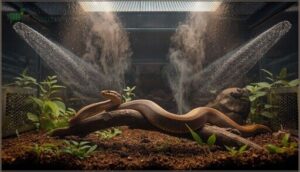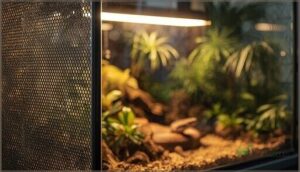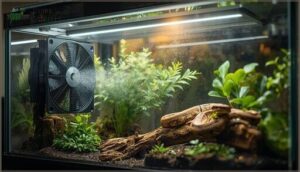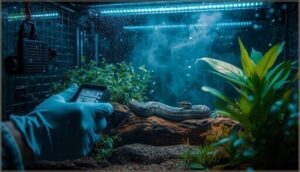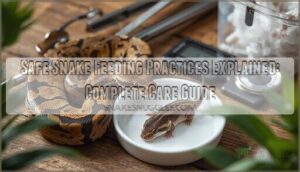This site is supported by our readers. We may earn a commission, at no cost to you, if you purchase through links.
A snake gasping for air in its own enclosure isn’t dramatic—it’s preventable. Respiratory infections strike up to 34% of snakes housed in poorly ventilated spaces, where stagnant air traps ammonia from waste and creates a breeding ground for pathogens. Your snake’s delicate airways weren’t designed to filter toxic gases day after day.
The difference between a thriving reptile and one struggling to breathe often comes down to airflow. Proper ventilation doesn’t just move air—it dilutes harmful gases, controls humidity, and mimics the natural conditions that keep respiratory systems strong.
Understanding how air moves through your snake’s enclosure can mean the difference between routine care and emergency vet visits.
Table Of Contents
Key Takeaways
- Poor ventilation causes respiratory infections in up to 34% of snakes by trapping ammonia and creating stagnant air where pathogens multiply unchecked.
- Proper airflow requires strategic vent placement with low intakes on the cool side and high exhausts on the warm side to create natural convection that exchanges air four to eight times per hour.
- Without adequate ventilation, ammonia levels can spike to 250 ppm within a week while temperature can rise 5-10°F above room temperature, both directly threatening your snake’s respiratory health.
- Different snake species need different ventilation setups—arboreal species require high air exchange with 50-70% humidity while desert species need maximum ventilation with humidity below 40%.
Why Ventilation Matters in Snake Enclosures
Your snake’s enclosure isn’t just a box—it’s a life support system. Without proper airflow, you’re practically asking your pet to breathe in a closet that traps heat, moisture, and harmful bacteria.
Let’s look at the critical reasons why ventilation directly impacts your snake’s health and survival.
Preventing Respiratory Infections
When proper ventilation fails, your snake faces real danger. Respiratory infections strike up to 34% of snakes in poorly ventilated enclosures. Ammonia exposure from waste irritates delicate airways and boosts infection rates by over 20%. Species susceptibility varies, but pythons show symptoms most often.
Poor ventilation puts your snake in real danger—respiratory infections strike up to 34% of snakes in stagnant air
Lower respiratory tract disease is common in snakes. Monitoring symptoms early matters. Disease prevention starts with airflow optimization and strong hygiene practices to protect snake health through proper snake enclosure ventilation.
Reducing Stagnant Air and Pathogen Growth
Stagnant air acts like a greenhouse for trouble. Without adequate air exchange rates, pathogen load reduction becomes impossible. Four to eight air changes per hour keep bacteria and fungi from taking hold. Poor air quality lets airborne pathogens multiply unchecked. Cross-contamination risks spike in closed setups. Effective VOC dispersion and mold growth control depend on consistent airflow. Temperature and humidity also play a key role in the survival of airborne pathogens.
Disease prevention starts with moving air.
Replicating Natural Habitat Conditions
Natural airflow patterns mirror what snakes experience in the wild. Most species inhabit environments where humidity balance stays between 50% and 80%, something proper air circulation helps maintain. Temperature gradients allow self-regulation in 80% of individuals, while light cycles sync with native biomes.
Substrate selection affects moisture retention by 18%. Ventilation transforms your enclosure into a natural environment that promotes health and normal behavior.
Preventing Overheating and Physical Stress
Beyond humidity balance, ventilation keeps your snake from overheating. Enclosures without proper airflow can trap 5–10°F more heat than the room outside. That disrupts thermal gradients your snake needs. Poor temperature control triggers basking behavior for over four hours daily and raises dehydration risk. Chronic heat buildup causes immune suppression and reproductive impact in gravid females.
Here’s what overheating stress looks like:
- Persistent tongue flicking and escape attempts
- Weight loss from reduced feeding frequency
- Abnormal shedding with poor skin elasticity
- Disrupted reproductive cycles in breeding animals
- Temperature spikes exceeding 92°F at basking spots
Proper snake enclosure ventilation using mesh tops or multiple vents can lower temperatures by 10°F, cutting overheating events by 70%.
Key Factors for Effective Enclosure Ventilation
You can’t just cut a few holes in your snake’s enclosure and call it good. Effective ventilation requires careful planning around placement, airflow balance, and your specific snake’s needs.
Let’s break down the key factors that separate adequate ventilation from systems that actually protect your snake’s health.
Strategic Vent Placement and Design
Think of vent placement as building an invisible highway for fresh air. Position three vents low on the cool side and three high on the warm end—this setup uses natural convection to pull stale air out while drawing clean air in.
Position side vents several inches above substrate to prevent mold. Cross-ventilation with opposite-wall placement maximizes airflow without losing heat.
Balancing Airflow With Humidity Control
When you dial up airflow patterns, humidity levels can drop by up to 25% in half an hour. Here’s how you maintain balance:
- Use misting systems to boost humidity by 20–35% within one hour
- Add humidity hide boxes that hold moisture 20–30% above ambient levels
- Choose substrates like coconut husk to reduce moisture loss by 18%
- Install automated humidity regulators to keep daily fluctuations under 5%
Adaptive enclosure systems protect snake health while maintaining proper temperature control and enclosure ventilation.
Adjusting Vent Size for Enclosure Volume
Matching total vent area to your enclosure’s interior dimensions creates proper ventilation and healthy air exchange rates. For a standard four-foot snake enclosure, aim for at least 76 cm² of combined vent opening to maintain effective enclosure ventilation.
Climate considerations matter—warmer regions demand larger vent surface area, while species size impact and vent material effects influence your volume-to-vent ratio adjustments.
Species-Specific Ventilation Needs
Different species breathe differently—your snake’s natural habitat dictates its airflow patterns and reptile health needs. Understanding species-specific needs prevents common ventilation mistakes that harm reptile care.
- Arboreal species like green tree pythons need high air exchange with 50–70% humidity and vertical airflow patterns to prevent respiratory disease.
- Desert species require mesh-top designs for maximum ventilation, keeping humidity below 40% to support their arid adaptations.
- Tropical species demand restricted airflow with 75–90% humidity—balancing tropical balance prevents dehydration while maintaining air quality.
Aquatic airflow above water zones and terrestrial humidity control complete your species-specific ventilation requirements for reptiles.
Health Risks of Poor Ventilation
Poor ventilation isn’t just an inconvenience—it’s a direct threat to your snake’s health. When air doesn’t move properly through an enclosure, harmful gases build up and pathogens multiply unchecked.
Here are the most serious health risks you need to watch for.
Increased Respiratory Disease Incidence
Poor ventilation creates a breeding ground for disease. When stagnant air traps pathogens, you’re setting the stage for serious respiratory infections.
Studies reveal that serpentovirus infection rates hit 37.7% in pythons housed with inadequate air quality, while clinical pneumonia cases in captive snakes show 47 distinct Gram-negative bacteria thriving in poorly ventilated spaces.
Your snake’s lung susceptibility factors make proper ventilation essential for reptile health.
Accumulation of Ammonia and CO2
Invisible threats build up fast when air stands still. Ammonia from waste can spike to 250 ppm in just seven days without ventilation, while well-circulated enclosures stay under 10 ppm. Carbon dioxide climbs too, disrupting your snake’s gas exchange and acid-base balance.
- Ammonia toxicity irritates respiratory tissue and weakens immune defenses
- High humidity accelerates waste breakdown and ammonia accumulation
- Elevated CO2 alters breathing patterns and causes metabolic stress
- Proper ventilation thresholds keep both gases safely diluted
Higher Pathogen and Mold Growth Rates
Stale, humid air becomes a breeding ground for danger. Bacterial concentration can double in just one week when static air traps moisture above 65%. Mold appears in 35% of non-ventilated enclosures within ninety days, while fungal dermatitis outbreaks jump by 35% annually in facilities with poor air quality.
Dirty substrate and high humidity influence pathogen growth directly. Cross-ventilation cuts these loads by 50–75%, protecting your snake’s respiratory health.
Observable Signs of Respiratory Distress
When your snake struggles to breathe, you’ll notice it. These warning signs demand immediate attention:
- Audible breathing: wheezing, clicking, or gurgling sounds occur in about 6% of captive snakes with poor air quality
- Postural changes: elevating the head and neck to improve airflow
- Mucous discharge: bubbles or foam from the mouth or nostrils appear in up to 60% of respiratory infections
- Membrane color: pale or blue-tinged oral tissues signal oxygen deprivation
Reduced responsiveness and feeding refusal follow shortly after.
Best Practices for Ventilation System Design
Designing a ventilation system isn’t about guesswork—it’s about creating airflow that keeps your snake healthy without compromising safety or environmental stability. The right setup combines smart placement, protective barriers, and sometimes a little mechanical help to maintain fresh air without creating escape routes or temperature swings.
Here’s what you need to build a system that actually works.
Incorporating Cross-Ventilation Techniques
Cross-ventilation works like a breeze through an open window. By placing low vents on your enclosure’s cool side and high vents on the warm side, you’ll create natural airflow patterns that drive out stale air.
This vent placement boosts air exchange to four to eight cycles per hour, cutting pathogen control issues while supporting humidity regulation and behavioral health.
| Enclosure Size | Recommended CFM |
|---|---|
| 4-5 feet | 55 CFM |
| 7-8 feet | 105 CFM |
| Small vivarium | 2-3 vents (5″x3″) |
| Large setup | Proportional increase |
Using Mesh and Safe Vent Covers
Mesh vent covers deliver proper ventilation while blocking rodents with 99% exclusion rates. You’ll want stainless steel or PVC-coated options that maintain airflow patterns for years without degrading. Choose apertures under 5mm to prevent escape—studies show 96% fewer incidents with secure mesh.
These safety standards protect your snake while reducing respiratory distress by half compared to poorly ventilated setups. Material performance matters for lasting health outcomes.
Integrating Mechanical Fans and Accessories
Adding mechanical ventilation transforms static air into a health-supporting system. You can achieve four to eight air changes hourly with axial fans rated at 55–105 CFM, depending on enclosure size. AC Infinity fans and computer cooling options deliver energy efficiency under 2 watts while reducing noise through lower RPM designs.
- Position one low intake and one high exhaust fan for consistent airflow
- Use 80mm computer fans on 5V USB for cost-effective ventilation systems
- Run fans 12 hours daily to control humidity without rapid drops
- Install protective mesh over all fan openings to prevent injury
- Choose adjustable speed controls for species-specific air quality needs
Maintaining Optimal Temperature and Humidity
With every ventilation adjustment, you’re shaping microclimate effects that determine your snake’s survival. Temperature gradients should span 75°F to 92°F across the enclosure, while humidity levels must stay between 60-80% for most species. Strategic sensor placement at multiple heights tracks these shifts accurately.
Proper airflow prevents the health impacts of temperature spikes and moisture extremes, directly protecting reptile health through consistent enclosure ventilation and humidity regulation alongside temperature control.
Maintenance and Monitoring for Air Quality
Even the best ventilation system won’t work if you don’t maintain it. Your snake’s enclosure needs regular attention to keep air quality where it should be.
Here’s what you need to stay on top of to protect your snake’s respiratory health.
Regular Cleaning and Odor Control
Think of your cleaning routine as the first line of defense against respiratory trouble in your snake. Waste removal and bedding choices directly impact ammonia buildup, which can skyrocket above 10 ppm without regular attention.
To keep your enclosure safe, follow these steps for maintaining cleanliness and removing odors:
- Spot clean waste 2–3 times weekly to minimize bacterial contamination
- Replace water bowls daily to prevent odor-causing bacteria
- Use absorbent bedding and filter options like carbon filters for ammonia removal
- Deep clean with reptile-safe disinfectant use every 4–6 weeks
This approach ensures effective odor control and water hygiene while protecting your snake’s respiratory health.
Monitoring Temperature and Humidity Levels
You can’t control what you don’t measure. Digital thermometers and hygrometers with probe placement at basking and cool zones give you real-time data on environmental parameters.
Species ranges matter—ball pythons need 50-60% humidity and 80-85°F, while milk snakes tolerate 40-60%. Variability effects like 20% humidity swings double illness risk.
Data analysis through memory recall features catches dangerous trends before respiratory trouble starts.
Observing Snake Health and Behavior
Your snake’s daily routine speaks volumes about air quality. Watch for respiratory distress signs like mouth-gaping or abnormal postures—5.6% of snakes in poor ventilation develop breathing problems.
Key stress behaviors and health markers include:
- Activity patterns: Well-ventilated enclosures boost exploration by 40% and reduce hypoactivity
- Skin abnormalities: Retained sheds affect 28% in compromised airflow
- Feeding changes: Appetite drops signal respiratory infections early
Fresh air equals vibrant reptile health.
Frequently Asked Questions (FAQs)
How often should I clean ventilation vents?
You should clean ventilation vents weekly to prevent blockages that cut airflow rates by half.
For high-humidity enclosures, increase cleaning frequency to every two weeks to control ammonia levels and maintain respiratory health.
Can I add ventilation to an existing enclosure?
Yes, you can retrofit ventilation by adding mesh vents or installing fans to existing enclosures. DIY vent modifications and fan installation improve airflow optimization, creating healthier airflow patterns through strategic ventilation design and mesh conversion techniques.
What mesh size is best for snake vents?
The best mesh size for Air Vents in Snake Enclosure Ventilation is 25 inches.
This ensures Escape prevention, ideal Mesh airflow, Humidity retention, and Material durability—while minimizing Biosecurity risks and supporting healthy Ventilation and Airflow.
Do baby snakes need different ventilation than adults?
Think of baby snakes as having smaller lungs in smaller rooms—they need proper ventilation but with careful humidity retention.
Juvenile airflow needs differ because hatchlings face shedding complications and metabolic ventilation demands when enclosure size matters for species-specific respiratory health.
How do I reduce drafts while maintaining airflow?
Position vents low on the cool side and high on the warm side for proper ventilation without strong currents.
Mesh solutions and fan shields prevent direct airflow.
Partial blocking with weather stripping controls air monitoring and maintains airflow.
Conclusion
Your snake won’t file a complaint about poor air quality—it’ll simply stop breathing well. The importance of ventilation in snake enclosures goes beyond comfort. It’s the invisible barrier between health and disease.
Clean airflow dilutes toxins, controls moisture, and keeps pathogens from gaining a foothold. Check your vents today. Adjust placement. Monitor humidity. Your snake’s respiratory system depends on what you can’t see but must never ignore.
- https://exoticreptilesforsale.com/ensuring-proper-ventilation-air-flow-and-circulation-in-reptile-living-spaces/
- https://www.evolutionreptiles.co.uk/blog/how-to-lower-humidity-in-vivarium/
- https://talis-us.com/blogs/news/maintaining-optimal-conditions-in-snake-enclosures
- https://pmc.ncbi.nlm.nih.gov/articles/PMC2846005/
- https://www.reptile-cage-plans.com/emails/howmuchventilation.html


